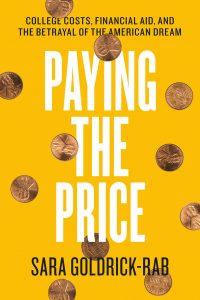Sara Goldrick-Rab on #RealCollege

Sara Goldrick-Rab, recently named one of *the* indispensable academics to follow on Twitter by the Chronicle of Higher Education, will publish her much-anticipated Paying the Price: College Costs, Financial Aid, and the Betrayal of the American Dream this fall. Needless to say, the book couldn’t be more timely—and important—to the continued conversation and policy debates surrounding the hyperbolic costs associated with American higher education. The book, which draws on Goldrick-Rab’s study of more than 3,000 young adults who entered public colleges and universities in Wisconsin in 2008 with the support of federal aid and Pell Grants, demonstrates that the cost of college is no longer affordable, or even sustainable—despite the assistance of federal, state, and local aid, the insurmountable price of an undergraduate degree leaves a staggering number of students crippled by debt, working a series of outside jobs (sometimes with inadequate food or housing), and more often than not, taking time off or withdrawing before matriculation. One of Goldrick-Rab’s possible solutions, a public sector–focused “first degree free” program, deserves its own blog entry.
In the meantime, here’s an excerpt from a piece by Goldrick-Rab recently published at the Washington Post, which provides human faces to some of the data circulating around the central issues:
When he runs out of options, some nights Sam sleeps in his car. The students he attends class with at Milwaukee Area Technical College don’t know — his bright smile, carefully assembled outfits, and optimistic chatter are all they see. But his friend Angel understands; he and his three sisters are barely able to make it day to day since their mom was deported. His older sister works full-time to support them and their elderly grandmother while Angel works on his associate’s degree.
Over at Madison College, Jenna has been taking a class or two at a time for nearly four years. She can’t do more while raising two children on her own, though food stamps help a bit. She’s frustrated and wishes it would be easier to finish her degree, so that she could get a better job and secure a better life for her family.
Every year about three in 10 college students leave college without a degree. Many receive financial aid and also work, but the prices are so high that they can’t make ends meet. Even at community colleges, their basic needs go unmet: food runs short, and safe housing is hard to come by.
Sam, Angel and Jenna have managed to stay in college despite the odds, and at the end of April they joined more than 150 people from around the country at the first-ever national meeting about college food and housing insecurity. Hosted by the Wisconsin HOPE Lab at Milwaukee Area Technical College, the #RealCollege convening was intended to inspire action. At the end of 2015, my team at the Lab published an op-ed in the New York Times describing our latest research about the prevalence of material hardship among the nation’s community college students.
Data from a survey of more than 4,000 students at 10 institutions around the country revealed that one in five was hungry, and 13 percent were homeless. Sadly, we weren’t surprised. Since 2008, we have been tracking food and housing insecurity in Wisconsin, while a handful of other scholars around the nation have been doing the same. It’s become increasingly clear that rising child poverty rates in the United States, coupled with broadened college enrollment, means that the same challenges confronting elementary and secondary schools now face colleges and universities too.
To read the Washington Post piece in full, click here.
For more about Paying the Price, click here.